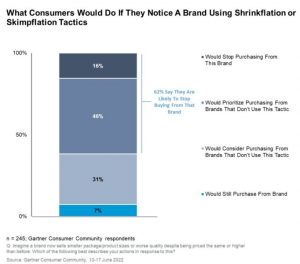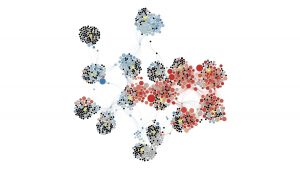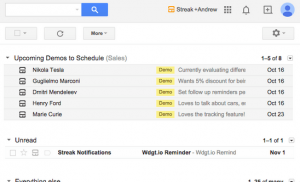— August 1, 2017
Everybody wants their piece of the pie.
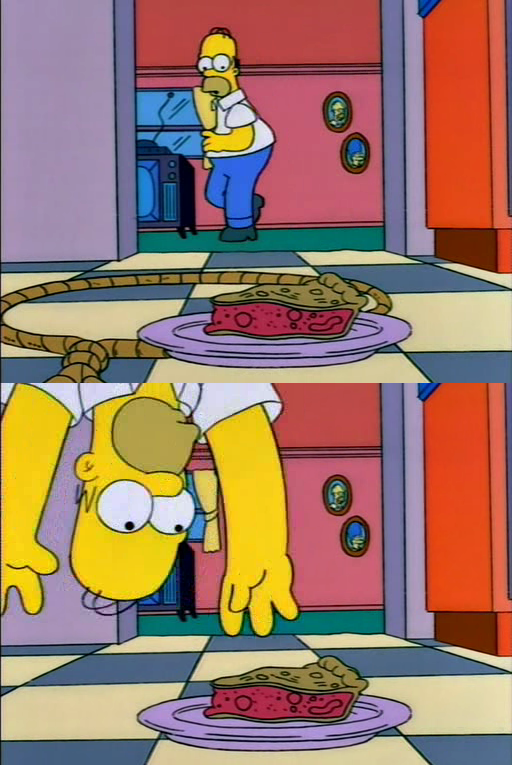
That mantra holds up whether we’re talking about dessert or the AdWords auction.
When it comes to the AdWords version of this proverb, the “pie” is the total amount of search queries where an advertiser wants to show their ads. If that advertiser’s ad gets an impression every single time a relevant search happens, they’re enjoying the entire pie. More likely, their ads will show for a smaller percentage of that total number of possible impressions.
Lucky for us as advertisers, Google provides a metric designed specifically to estimate how much of the pie we’re getting and why we’re missing out on the rest. That metric is Search Impression Share.
By definition, impression share is the percentage of impressions that your ads receive compared to the total number of impressions that your ads are eligible to get.
Impression Share = actual impressions / total eligible impressions
That eligibility is determined by the keywords you’re bidding on, as well as settings such as location targeting and ad scheduling that determine the extent to which your ads can show.
The Importance of Impression Share
So why is this metric important? It’s the perfect tool to identify missed opportunity within your account. While most of the metrics Google gives us in AdWords help to gauge how our campaigns are performing currently, impression share tells us how much more we could do.
I always stress that impression share is not a “good vs. bad” type of metric, the way something like Quality Score can be evaluated. Instead, it’s all about identifying opportunity. A low search impression share isn’t necessarily a bad thing; it simply means that a campaign has a lot of opportunity remaining.
For that reason, impression share is a metric to pay attention to once a campaign is well optimized and returning a profitable cost-per-conversion. You shouldn’t worry about impression share when your campaign is in its infancy, casting a wide net with general keywords. Wait until you’ve tightened things up, and then use impression share to scale your success.
Analyzing Your AdWords Impression Share
WordStream displays impression share in a colorful column on the Campaigns tab:
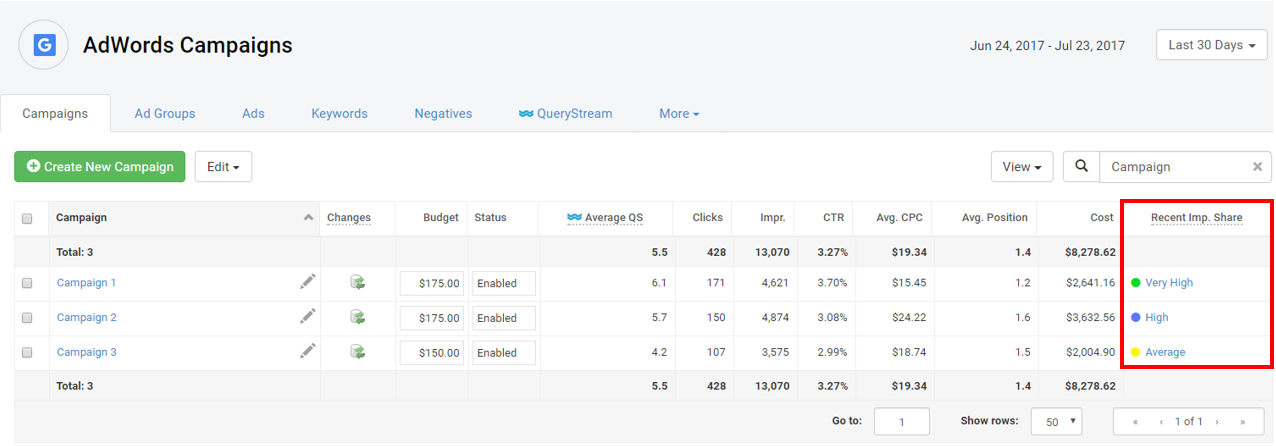
Each campaign will show a Recent Impression Share status ranging from Very Low to Very High. Clicking on that status will open a bar graph that can be viewed in a Daily, Weekly or Monthly view.
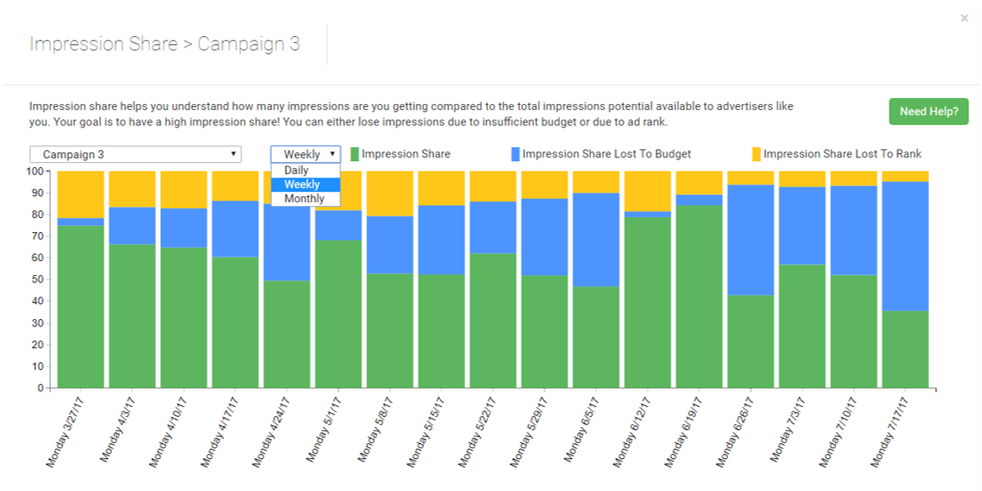
The green portion represents the percentage of eligible impressions your ads in the selected campaign are getting. The rest of the bar represents impression share lost. Those impressions are being lost for one of two reasons: low ad rank (yellow) or budget restrictions (blue).
So, that’s great – now you know how much of the pie your campaigns are getting, and why they’re losing out on the rest. But what can you do about it?
The actions you can take to increase impression share depend upon the reason you’re losing that share. Let’s dive into each of those two reasons separately.
Search Impression Share Lost to Ad Rank
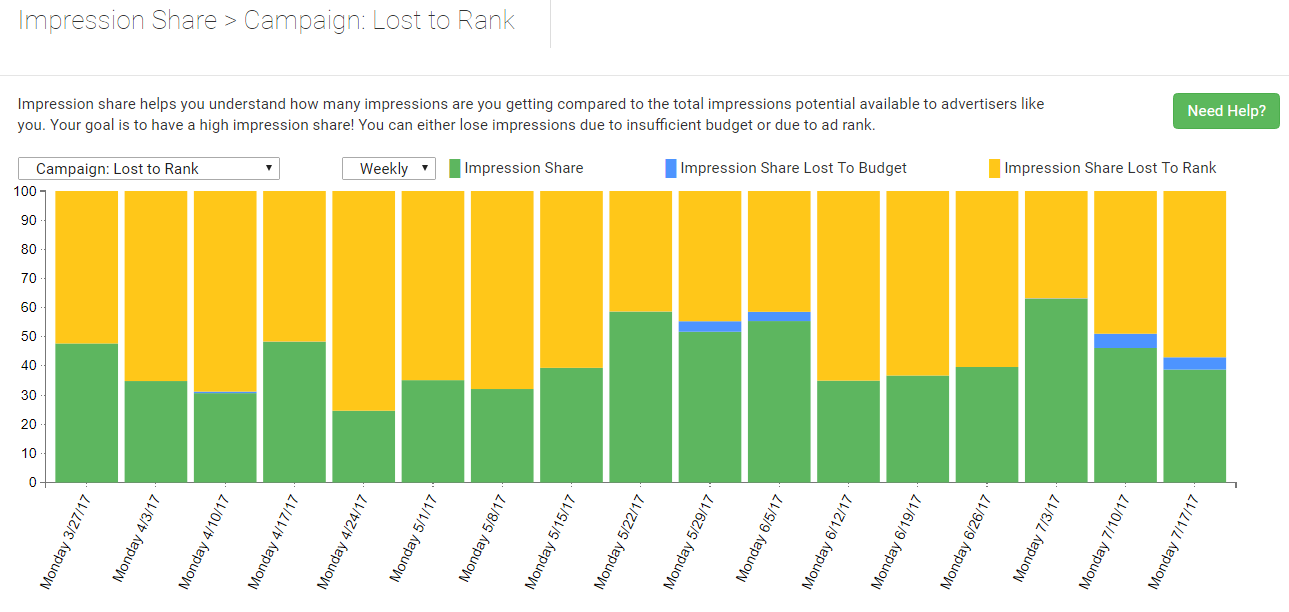
When your campaign is losing impression share to ad rank, it means that your keywords are entering the auction with an ad rank that isn’t high enough to win you an impression some percentage of the time. Google uses the following formula to calculate ad rank:
Ad Rank = Max CPC Bid x Quality Score
Therefore, there are two levers we can pull to increase impression share when it is being lost to low ad rank.
1) Increase Max CPC bids. This is the quick and dirty way to improve your ad rank and get a higher impression share. By simply increasing your Max CPC bids, you’ll improve your ad rank by telling Google you’re willing to pay more per click. If your keywords already have a good Quality Score but are getting few impressions and/or a low average position, that’s a good indication that raising your bids is necessary to maximize their performance.
2) Improve Quality Score. This is the more cost-effective way to improve ad rank and thereby increase impression share. If you can boost your keyword’s Quality Score, you’ll be able to achieve a higher ad rank without having to spend more money. Look for opportunities to split your ad groups into smaller, more tightly-themed groups of keywords so that you can write more relevant Expanded Text Ads and landing page copy. Ensure that you are utilizing ad extensions, as those will contribute to a higher click-through rate which in turn will improve your Quality Score.
Keep a close eye on your impression share graphs as you make these adjustments to your bids and optimize for Quality Score. If your changes are having the desired effect, you should see a decrease in the yellow portions of those graphs and an increase in the green.
Search Impression Share Lost to Budget
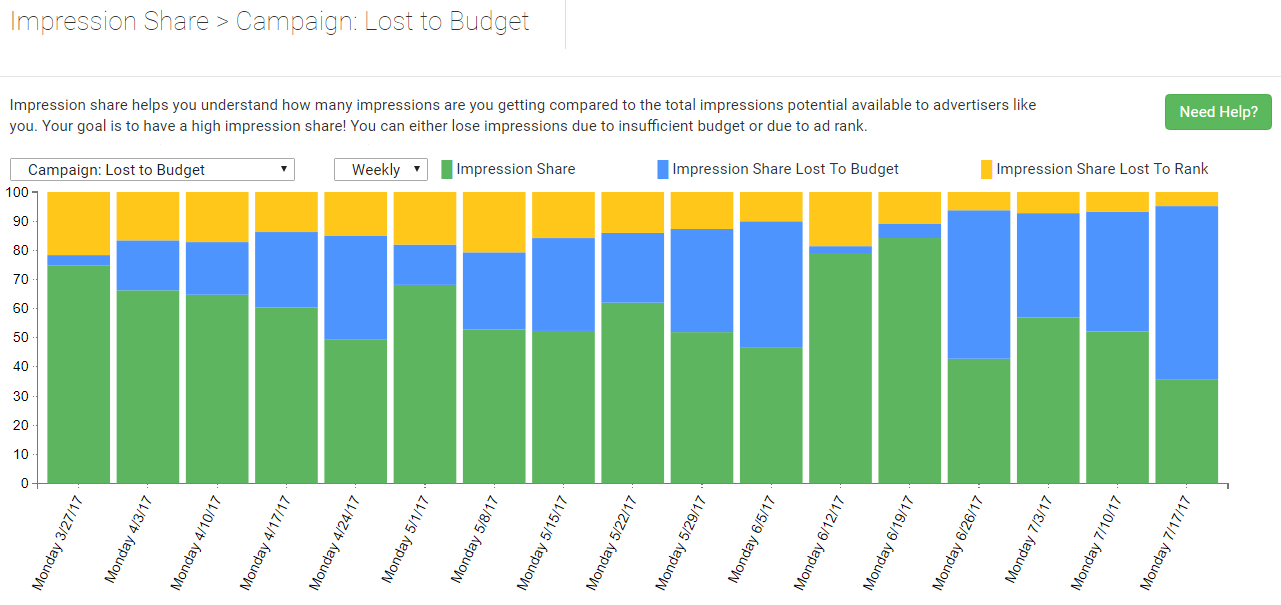
Impression share lost to budget is more self-explanatory. In this case, your keywords are eligible for additional impressions that you currently aren’t getting because the budget you have allocated to your campaigns is running out. Give those campaigns more budget to work with, and they’ll reward you with a higher volume of impressions.
Once again, the quick and dirty way to increase impression share when you’re losing to budget is to simply throw more money at it. However, that might not be the only (or best) solution.
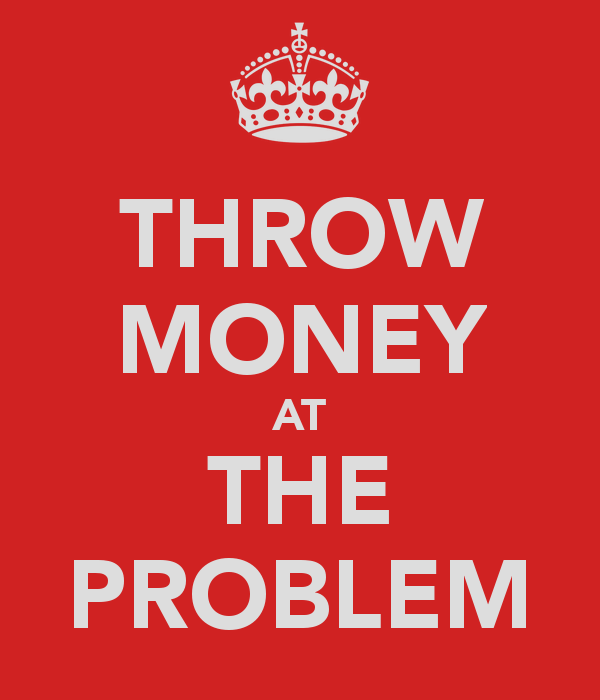
Here are a few other strategies to try.
Audit your keywords
The first course of action when a campaign is losing impression share to budget should be to audit its keywords. Watch out for broad match keywords, single-word keywords and overly general keywords, as these may be eligible for a wide array of impressions that you don’t even want. Tightening up your keywords with more restrictive match types and longer-tailed, more specific terms can make your campaign more efficient and achieve a higher impression share without needing to increase your budget.
Check average position
Second, evaluate your keywords’ average position. If you’re consistently showing up near the top of the page, you have an opportunity to decrease your Max CPC bids. While this may mean that you show up in a slightly lower average position, it’ll also result in a lower average cost-per-click. That will allow you to get more clicks within your existing budget, maximizing search impression share without having to pay more for it.
Work on Quality Score
I mentioned Quality Score optimization as a way to increase impression share when it’s being lost to ad rank, and the same strategy applies for impression share lost to budget. Improving QS means you can achieve the same ad rank at a lower Max CPC bid, allowing you to stretch your budget farther without actually increasing it.
Last resort…
Finally, if you’ve looked for these opportunities and your campaign is optimized but still losing impression share to budget, simply increasing your daily budget will allow you to scale it. A campaign that is returning conversions at a profitable cost while losing impression share to budget indicates clear opportunity to bring in more conversions at the same cost per acquisition when its budget is increased.
Search Impression Share is High or Very High…Now What?
Once you achieve a High or even Very High search impression share on a campaign, its graph will show a whole lot of green.
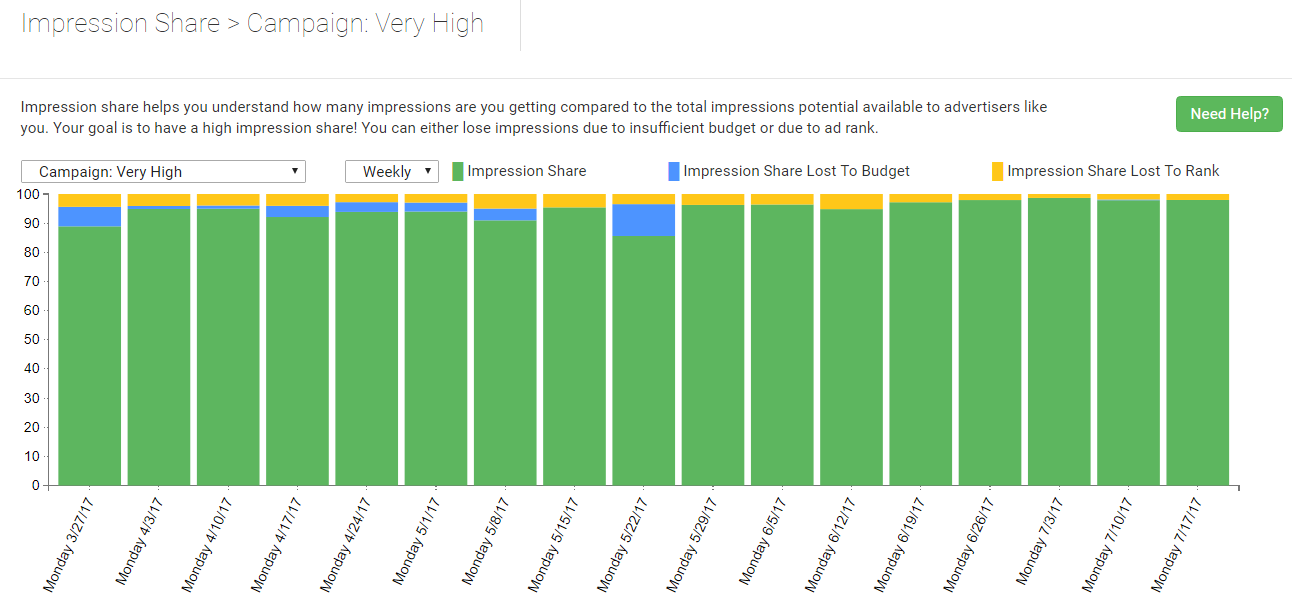
This means that for the vast majority of searches your target audience is performing on your keywords, your ad is showing up. Fantastic!
But…now what? Does this mean you’ve tapped out the potential of paid search and reached the limit of what it can provide?
Of course not! If your campaign has reached a high search impression share, it’s time to think about expanding.
This could mean doing additional keyword research to discover new ad group and keyword concepts to test in your campaign. You could even try running a broad match keyword for a while to expand your reach, which can clue you into quality search queries you may not have come across in your keyword research.
Expansion may also mean trying out some new advertising platforms, like Bing or Facebook. If you’re maximizing the search impression share on an AdWords campaign, importing it into Bing Ads could be a great way to keep growing your business.
So, check out the recent impression share for your campaigns, and find out where the opportunity lies. Google will supply the pie – it’s up to you how big of a piece you can get!
Digital & Social Articles on Business 2 Community
(58)
Report Post


